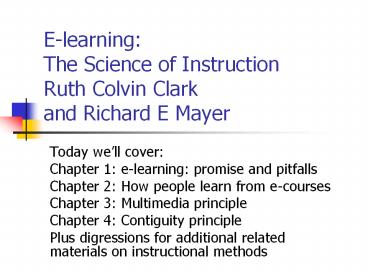E-learning: The Science of Instruction Ruth Colvin Clark and Richard E Mayer - PowerPoint PPT Presentation
Title:
E-learning: The Science of Instruction Ruth Colvin Clark and Richard E Mayer
Description:
Plus digressions for additional related materials on instructional methods ... E.g., driving a golf ball or driving a crane. Require coaching and detailed feedback ... – PowerPoint PPT presentation
Number of Views:308
Avg rating:3.0/5.0
Title: E-learning: The Science of Instruction Ruth Colvin Clark and Richard E Mayer
1
E-learning The Science of InstructionRuth
Colvin Clark and Richard E Mayer
- Today well cover
- Chapter 1 e-learning promise and pitfalls
- Chapter 2 How people learn from e-courses
- Chapter 3 Multimedia principle
- Chapter 4 Contiguity principle
- Plus digressions for additional related materials
on instructional methods
2
The e-Learning Bandwagon
- 90 of universities have distance learning
- Does this include Lehigh?
- U of Phoenix, Athabasca U, etc., entirely online
- Verizons Virtual University hosts most technical
training - U.S. Army partners with PricewaterhouseCoopers
- Companies are spending 50-60 billion/year on
e-learning. Are you impressed? - What is a knowledge-based economy?
- Is e-learning a key to knowledge-based economy?
3
What is e-learning?
- Instruction delivered via computer
- Content relevant to learning objectives
- Uses instructional methods such as examples and
practice - Builds new knowledge and skills
4
Media instructional methods
- Media elements present and illustrate content
- Text, audio narration, music, graphics, animation
and video - E.g., Dreamweaver course uses audio narration and
animated graphics - Instructional techniques support learning
- Examples, practice exercises, feedback
- E.g., Dreamweaver lesson uses simulation practice
- Why might simulating an actual work environment
be particularly effective?
5
When to use e-Learning (from Margaret Driscoll,
Web-Based Training)
- Cognitive skills solving problems, applying
rules, distinguishing items - E.g., how to complete tax forms
- Psychomotor skills coordination physical
movement and thought - E.g., driving a golf ball or driving a crane
- Require coaching and detailed feedback
- Attitudinal skills opinions and behaviors
- E.g., whether to recycle
- Which is hardest to teach with multimedia?
6
Which skills are most suitable for e-learning?
- CPR training?
- Developing a sort algorithm?
- Supporting a political party?
- Driving a stick shift?
- Finding and using Photoshop plug-ins?
- Trouble-shooting printer problems?
- Discuss in small groups.
7
Three theories of learning(see check boxes on
page 33)
- Response strengthening
- Strengthen stimulus-response associations
- Drill-and-practice with reinforcing feedback
- Information acquisition
- Learning adds information to memory
- Instruction delivers information efficiently
- Knowledge construction
- Learner builds a mental representation
- Guide learner in the context of solving problems
- Is one theory right? Or a combination?
8
The Art of Changing the Brain(James E. Zull)
- The Learning Cycle Sense ? Integrate ? Act
- Learning originates with concrete sensory
experience - Reflective observation integrates inputs in
patterns and develops generalizations or
abstract hypotheses - Active learning tests the results of motor output
9
Types of e-Learning goals
- Inform build awareness, e.g., about a companys
organization - Perform build skills, e.g., how to use software
or how to evaluate bank loans - Procedural step-by step tasks
- Near transfer from training to application
- Learning Dreamweaver may involve near transfer?
Why?Give an example. - Principle-based guidelines and problem-solving
skills - Far transfer from training to application
- Why does learning how to evaluate bank loans far
transfer?
10
How do people learn?
- Two information processing channels
- visual and auditory, each with limited capacity
(attention) - Working memory has limited capacity
- 7 chunks plus or minus 2
- Learning occurs by active processing
- From working to long-term memory
- Rehearsal encodes knowledge
- Knowledge must be retrieved from memory
- Retrieval brings knowledge back into working
memory
11
One minute paper
- How might understanding the way people process
information and learn affect the way you design
multimedia e-learning activities?
12
Pitfalls of e-Learning
- Failure to do job or skill analysis
- Presenting skills and knowledge out of job
context risks transfer failure - How could this pitfall affect your project?
- Failure to accommodate human learning
- Multimedia can actually depress learning if it
overwhelms limits of human processing - Attrition e-Learning dropouts at least 35
- Games and stories may detract from learning Why?
13
Do these techniques aid or hinder human learning?
Why?
- Using an arrow or color to draw the eye to
important information? - Listing learning objectives up front?
- Including background music?
14
e-Learning Research
- Informal studies observing people as they learn
or asking them about it - Formative evaluation makes changes from learner
feedback - Summative evaluation reports results to sponsors
others - Formal studies use experimental research design,
with subjects randomly assigned to test and
control groups - Controlled compare outcomes of 2 or more groups
of learners - Clinical trials evaluate e-learning in real
world contexts - Should show statistical significance (plt.05)
- Effect size mean difference / standard deviation
- Book uses results of controlled studies that
suggest basic design principles for e-learning - Why are experimental studies useful to designers?































